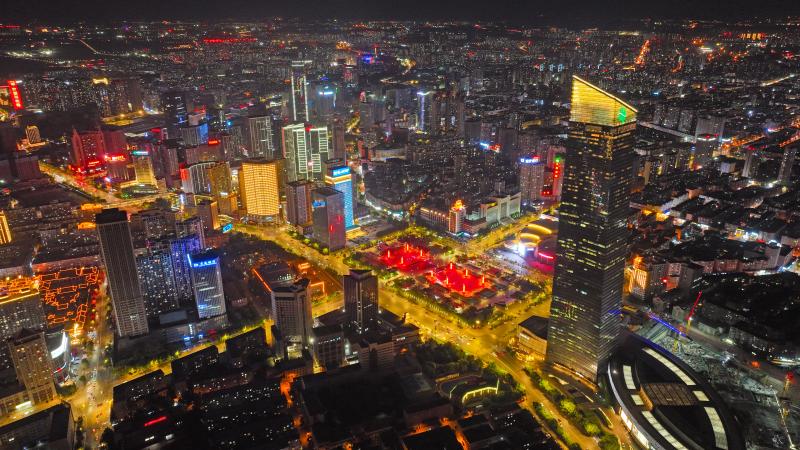People's Leaders | Two Banyan Trees Reflecting Inheritance
The banyan tree has an amazing vitality. No matter how barren the land is, or even on a rocky cliff, it can always break through the ground and stand proudly in the sky.
On March 12, 2000, 87-year-old Xi Zhongxun and his family planted a banyan tree in his residence, Orchid Garden, Shenzhen. Xi Zhongxun said to the staff around him: "I also want to take root in Shenzhen."
As one of the main pioneers and important founders of Guangdong's reform and opening up, Xi Zhongxun planted this banyan tree to express his wish to take root in the hot land of reform and opening up.
In December 1978, the Third Plenary Session of the 11th Central Committee of the Communist Party of China made the historic decision to shift the focus of the Party and the country's work to economic development and implement reform and opening up, which opened a new historical period of reform and opening up and socialist modernization.
A few months later, Xi Zhongxun, then the first secretary of the Guangdong Provincial Committee of the Communist Party of China, proposed at a central work conference that he hoped the central government would give Guangdong more autonomy and take the lead in reform and opening up. He said: "Guangdong is close to Hong Kong and Macao and has a large number of overseas Chinese. We should make full use of this favorable condition and actively carry out foreign economic and technological exchanges."
This bold proposal was made by Xi Zhongxun after an in-depth investigation in Guangdong.
In July 1978, Xi Zhongxun went to the countryside for research, and his first stop was Bao'an County. A river runs through Luofang Village, dividing the village's farmland into two halves, one in Guangdong and the other in Hong Kong. Xi Zhongxun learned that the average annual income of the villagers in Luofang Village on the Guangdong side was only 134 yuan, while the average annual income of the villagers in Luofang Village on the other side of the river in Hong Kong reached 13,000 Hong Kong dollars.
On the Chung Ying Street, he saw that the Hong Kong side was crowded with people and traffic, while the mainland side was overgrown with weeds and desolate. When he came to the lychee orchard and heard the fruit farmer sigh about selling lychees for only eight cents per pound, he thought for a long time...
In August 1978, Xi Zhongxun conducted research in the rural areas of Huiyang, Guangdong. Xi Jinping, who was studying at Tsinghua University, took advantage of his summer vacation to participate in social practice and went to the countryside with his father.
That summer, Xi Zhongxun traveled to 23 counties in a row.
After mastering the real situation in Guangdong, Xi Zhongxun proposed a series of groundbreaking reform suggestions to the central government, which were supported by the central government. In March 1979, Shenzhen was established. Soon after, Comrade Xi Zhongxun again proposed to set aside a piece of land in Shenzhen, Zhuhai and Shantou, which are adjacent to Hong Kong and Macao, as an investment place for overseas Chinese, Hong Kong and Macao compatriots and foreign businessmen. This suggestion was taken seriously by the central leadership. In August 1980, the Party and the State approved the establishment of special economic zones in Shenzhen, Zhuhai, Shantou and Xiamen.
During the more than two years he worked in Guangdong, Xi Zhongxun did a lot of pioneering work.
He led the people of Guangdong to explore ways to adjust the rural economic structure, and proposed to develop cash crops, animal husbandry and fisheries, and agricultural and sideline product processing and other collective enterprises under the premise of ensuring self-sufficiency in grain. He also took advantage of Guangdong's geographical proximity to Hong Kong and Macao to promote small-scale border trade and introduce Hong Kong businessmen to invest in factories processing imported materials... A series of innovative measures laid the foundation for Guangdong to take the lead in China's reform and opening up.
Xi Jinping was deeply influenced by his father's great practice of leading the people of Guangdong to emancipate their minds and carry out reforms at the beginning of reform and opening up.
In 1982, Xi Jinping took the initiative to apply for local work, leaving the General Office of the State Council and the General Office of the Central Military Commission and coming to work in local areas.
During his work in Zhengding, Hebei, faced with the problem of varying degrees of shortage of scientific and technological talents and technical backbone forces in most enterprises and units in the county, Xi Jinping proposed nine employment measures after in-depth research, including "boldly employ and widely accept all kinds of talents", "allow research projects to fail without pursuing responsibility, and pay wages and round-trip transportation fees".
The "Nine Articles on Talent" involved many aspects such as the allocation system, personnel system, food policy, and household registration management, and it was a groundbreaking move at the time.
In 1983, Xi Jinping, then secretary of the Zhengding County Party Committee in Hebei Province, temporarily set up a table on the street to listen to the opinions of the people.
During his work in Fujian, Xi Jinping summarized the "Jinjiang Experience" after many investigations and proposed the development direction of the county economy; advocated the establishment of a "one building" for foreign economic cooperation and promoted streamlining of administration and delegating power; and took the lead in carrying out reforms of the collective forest rights system.
While working in Zhejiang, Xi Jinping proposed the "Eight Eight Strategy"; when he arrived in Shanghai, he vigorously promoted the integration of the Yangtze River Delta... These reform methods and experience summaries, which were based on in-depth investigations and research in different places, focused on current and long-term development and formed in local practices, still have important practical and guiding significance in the new era.
Xi Jinping stressed that the key to dealing with the series of contradictions and challenges facing my country's current development lies in comprehensively deepening reform, which also means that reform must have the perseverance and courage to advance into deep waters, tackle tough problems, and wade through dangerous shoals.
Since the 18th CPC National Congress, the reform of the household registration system has broken down the barriers between urban and rural areas, the reform of the judicial responsibility system has eliminated the stubborn problem of "those who try do not judge, and those who judge do not try", the concept of "clear waters and green mountains are gold and silver mountains" has been deeply rooted in the hearts of the people, the implementation of the negative list system for market access has become a microcosm of the continuous improvement of China's market system, and "running once at most" has gradually replaced "unpleasant faces, difficult to enter, and running around", and the government's functions have undergone profound changes...
Some American scholars say that China's aggressive anti-corruption efforts are reforms, rule of law is reform, poverty alleviation is reform, military restructuring is reform, and the reform of party and government institutions is also a major reform. A scholar who participated in the drafting of the documents for the Third Plenary Session of the 18th CPC Central Committee recalled: "Without Xi Jinping's determination, many major reforms would have been difficult to implement."
People also gave similar comments on the responsibility shown by Xi Zhongxun in firmly promoting Guangdong's reform and opening up.
An old comrade who worked with Xi Zhongxun admitted: "If Comrade Xi Zhongxun had not proposed decentralization so sharply and clearly, Guangdong would still be stagnant." "He turned the consensus on expanding local autonomy from theoretical discussion into practical action that can be implemented in Guangdong."
On December 8, 2012, Xi Jinping planted a mountain banyan tree in Lianhuashan Park in Shenzhen, Guangdong.
The inheritance of the spirit of not fearing difficulties and daring to take responsibility between father and son and the reform relay of daring to change and innovate between the two generations of Communists are self-evident. As Xi Jinping wrote in his birthday letter to his father Xi Zhongxun, "I will learn from your conduct" and "I will learn from your work."
In 2012, after the 18th National Congress of the Communist Party of China, Xi Jinping chose Guangdong for his first local inspection.
In Shenzhen Lianhuashan Park, Xi Jinping presented a flower basket to the bronze statue of Deng Xiaoping and planted a banyan tree in the square on the top of the mountain. Here, he reviewed the reform path of his fathers, thought about the reform path after China's reform entered the deep water zone, and issued a mobilization order to deepen reform.
Today, the two banyan trees planted by Xi Zhongxun and Xi Jinping in Shenzhen have grown into towering trees. With Guangdong as the starting point of China's reform and opening up, China, after experiencing tremendous changes, is drawing a new blueprint for building a modern socialist country in an all-round way and striving towards the great cause of building a strong country and national rejuvenation. Looking at the present, we need to carry forward the tenacious spirit of the banyan tree, which is deeply rooted and fearless of difficulties, to further deepen reform in an all-round way.
Proofreading: Cai Chunlin, Lu Yang, Meng Lizheng, Liu Zhen, Yan Tiantian, Mao Changzhi




